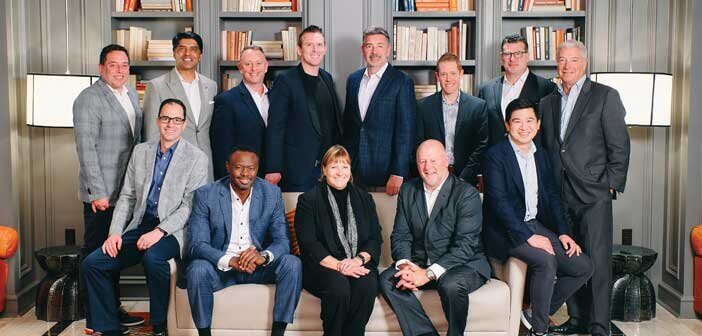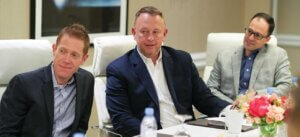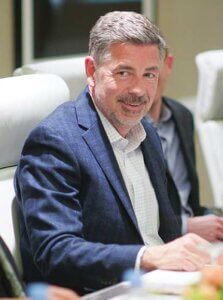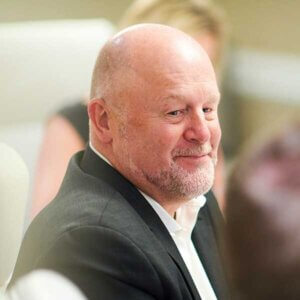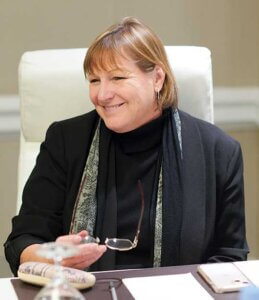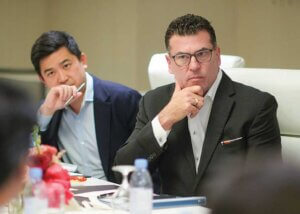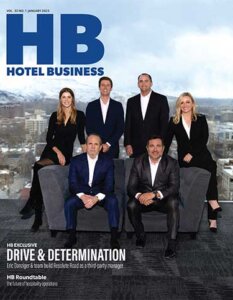2023 is here. What was deemed to be the year for recovery looks a lot more like a year for rebuilding the rethinking hotel operations.
The hospitality industry needs to operate both efficiently and creatively to succeed and move into the future. Inflation, supply chain issues and the labor shortage continue to plague hospitality, and while numbers show signs of hope, the consensus among experts has been the same: We need to innovate and embrace new technologies to maximize profits.
At a recent Hotel Business Roundtable held at the end of last year, sponsored by Actabl and hosted by Remington Hotels at the Melrose Georgetown Hotel in Washington, DC, leaders gathered to discuss these topics.
Moderated by Christina Trauthwein, VP, content & partnerships, Hotel Business, the group of panelists included Sloan Dean, CEO, Remington Hotels; Chris Green, president, Remington Hotels; Adam Glickman, VP, marketing, Actabl; Jason Luo, CRO, Actabl; Paul Bennie, VP, strategic accounts, Actabl; Greg Winey, president/principal, NorthPointe Hospitality Management; Brian Quinn, chief development officer, Sonesta; Chip Rogers, president/CEO, AHLA; Ben Seidel, CEO/president, Real Hospitality Group; Naveen Kakarla, president/CEO, HHM; Helinda Lizarraga, president, Aligned Hospitality Management; Evens Charles, founder/managing principal, Frontier Development & Hospitality Group LLC; and Adam Gollance, CEO, Modus by PM Hotel Group.
The conversation began with a look forward: What should hoteliers focus on? What does the future hold for hotel operations?
“Next year [2023] could be a really good time to lock in your talent plan, raise some rates [and]do a little bit of renovation,” Quinn said. “I think we all deserve to run through the tape, enjoy the occupancy and try to heal up all the businesses after everything we’ve been through.”
Glickman noted that there’s also a real opportunity to protect profits, especially as rate continues to rise and inflation impacts wage and labor costs.
“As we get into more city center hotels having better success, that’s going to impact the hours of labor per occupied room,” he said. “As hours of labor per occupied room goes up, wages go up, and that impacts profits unless you start making strategic decisions. To get more done with less, you need to optimize the labor you have. I think a big part of 2023 is how you dial up optimization of labor so that you can protect the profit generation you made this year and heading into next year.”
And profits exist outside of the guestroom as well, especially as more people work remotely, using hotel spaces as home offices.
“Our per occupant per room is up, and it’s something the industry should do a study on because what it’s doing is putting a strain on restaurants and lobbies,” Dean said. “We see this trend in housekeeping because there’s the trash in the room and it takes longer per occupied room to clean. But it also presents an opportunity for full-service hotels to drive more bar contribution to do other things that maybe you didn’t do before because your mid-week traveler isn’t who they used to be. It’s a strain but an opportunity. You need to learn how to monetize that and reinvent some of the public spaces.”
Technology is crucial in this department as it not only helps operationally but, as Dean noted,
it presents opportunities that we didn’t have in the past.
“How many people here at your companies have created policies that allow for remote work?” Rogers asked, to which all the participants raised their hands. “And, for the most part, people aren’t remotely working from home.”
Guests are changing—they’re traveling for leisure during the workweek and they’re bringing their families along with them. In fact, Rogers noted, those combining work and leisure travel can help hotels fill rooms they normally wouldn’t with a guest traveling solely for business.
“A word I use a lot in leadership is curiosity, and I think we’ll never have to be more curious about how we optimize every single square foot in our building [and]how we use technology to leverage and monetize each square foot and drive profit there,” Green said. “With our data, we’re not only able to ascertain what’s selling and where it’s selling, but we’re looking at beacon technology. It makes everywhere in your hotel somewhere that you can buy something.”
Efficient operations
In an industry not particularly known for innovating, this can present some challenges. Still, the good news is there are ways to optimize data and make operations more efficient, while also enhancing experiences.
“Are we ready for it on the technology side?” Winey asked, adding, “The phone is the key that controls everything in the room. People want efficiency. We need to look at how we design hotels today to be much more efficient. Hotels will probably mandate that you use a texting service. You want to capture data and habits.”
Easing operational challenges may also strengthen company culture, which is still a major concern among leaders as labor remains scarce.
“There’s one reason [hospitality]doesn’t feel as fun as it did pre-pandemic even though we’re prepared to run through the tape,” Seidel said. “It’s just that feeling of having to respond and be reactive to employee needs, vendor needs, your delivery times [and]what you can get when you can get it. What is my rate going to be? What is the percentage of recourse? It’s constantly reacting to something every minute of every day, and that’s really exhausting.”
Kakarla said he’s “guardedly optimistic” about 2023, feeling like the industry is going from one set of headwinds to some others.
“A year ago, I would have thought that we would have worked through most of it,” he said. “We had inflation and labor pressures and supply chain [issues], and we’ve certainly gotten through the latter two better than we did a year ago. But inflation is a real headwind, and I don’t think we’ve settled on a clear plan for how to work through it. I do think that as labor becomes more available, we have to focus on re-attracting the hourly positions versus the salary positions. It’s starting to get better because of advocacy, and education and things we have to do to stabilize hotels.”
Talking about culture is one thing, but acting on it and creating policies to bring it to life is quite another. If the industry doesn’t do this, it may be attracting the wrong kinds of employees, the participants warned.
“Culture is values plus your behavior,” Gollance said. “Focus on your behaviors; don’t worry about just talking about the culture. It’s important, but it’s your actual behavior.”
Taking care of employees—a group that was forced to operate lean during the pandemic—will, in turn, take care of your customers, Charles pointed out. This, along with rolling out the proper technology, will hopefully ease the exhaustion Seidel referred to.
“Technology and also partnering with the brands as they roll out new technology to make operations more efficient, improving the guest experience and incremental revenue opportunities that we can find are key takeaways,” Charles explained. “We were forced to operate with a lot less [during COVID], so what lessons can we take from that experience and continue to implement now? I think customer needs are changing. Let’s try to understand what those are and be more accommodating.”
Seidel pointed out that all the participants are certainly pro-brand and should push themselves to figure out what the brand vulnerabilities are and where they dropped the ball with technology.
Quinn agreed. “We are not used to technology,” he said, suggesting that hotels should work to monetize the phone and take notes from how other industries utilize tech to improve efficiency. But it doesn’t just stop at the phone. Sometimes, it’s as simple as a bed and bath.
“We sent a man to the moon 53 years ago, and we can’t figure out how to get a tub cleaned at times? It just seems ridiculous,” Winey said. “How can we figure that out? At the end of the day, you’re there for a bed and a bath, and that has never changed in our business. And that’s not likely to change. How do we turn that room around quicker and also pre-engage the guest? If we can do that, it takes pressure off.”
It’s not just technology, Dean said, but it’s figuring out how to do the same occupancy the industry ran in 2019 with less staff and deliver the same level of service or better.
“That’s what we have to reengineer,” he said. “Figuring out what the customer wants, and changing to meet those needs.”
For Glickman, as younger guests not only embrace technology but rely on it, the concept of matching changing consumer demand to offerings is essential.
“Think about the future of our workforces and Gen Z and how they engage with their friends and all the platforms they’re on every day,” Glickman said. “You have to match how they live their life. Daily pay is a great example of that.”
For those just entering the workforce who don’t have access to a pool of savings, daily pay can not only make their lives easier but also improve the relationship with their employer.
“The opportunities are the intersection of how technology and tools help our industry move forward,” Glickman said. “It’s not the same way we’ve always operated for 100 years. You might not need a front desk agent working 24/7. Maybe you don’t need a housekeeper who’s doing the exact same kind of service. As leaders, we have to think about how technology enables the changing profile of what a hotel looks like in the future.”
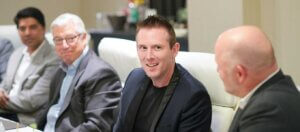
Naveen Kakarla, HHM; Ben Seidel, Real Hospitality Group; Sloan Dean, Remington Hotels and Greg Winey, NorthPointe Hospitality Management
Kakarla said he wishes he implemented daily pay a year earlier as he’s already witnessed the benefits.
“It feels like a smaller business and a much better relationship with your employer if you can just ask [for payment],” he said. “Daily pay is one of the simplest things we can do to be sensitive to our people.”
Listening and balance
Although technology is essential, Lizarraga brought up a crucial, yet often overlooked, aspect of leadership which can make all the difference: listening.
“Listen to the line level and GMs,” she said. “The way the industry is changing is amazing. The way we did it years ago…we can’t do it that way. You can, but you’re going to have more success if you pivot, you follow them, you listen to them and make changes
in technology.”
It all comes back to “balance,” said Bennie, who counted that the participants said the word 13 times during the discussion. Yet, the industry seems to be out of sync right now.
“If you think back, we hit a high in 2019 and very quickly hit an extreme low, and now we’re back to highs,” he said. “It’s not just highs in ADR. It’s highs in labor costs and in guest expectations, but we’re still dealing with lows. We’re not in balance with owners, brands, debt service, operators. We are out of sync and struggling in these areas. We’re working on it and talking about it, but I think as we go into this next year and 2024, we’re going to be going through this rebalancing of what it is we need in this industry, how we deal with guests’ expectations, operations and the cost of making that work.”
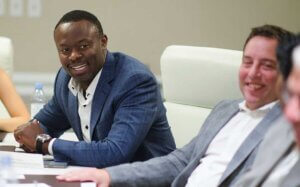
Evens Charles, Frontier Development & Hospitality Group LLC; and Adam Gollance, Modus by PM Hotel Group
Balance, which Gollance also believes to be key, is also about mitigating losses and profit pressures by focusing on the people willing to pay a premium for experiences.
“We know it, we’ve seen it and if we can do something super cool, people will pay for it,” Gollance said. “It’s a balance because you need to have someone who knows that local market [and]knows the cool places to go to. It’s not just your phone.”
Putting team members in the right roles will matter for how guests enjoy these experiences, Glickman noted.
“How do you optimize the team member for something only they can do that you can’t get on the phone?,” he asked. “That becomes the opportunity: The things that only a person can do to bring that experience to life.”
Experiences today, specifically wellness experiences, extend far beyond simply offering a gym, a spa or yoga studio, and now include full concepts.
“We are starting to see from a technology perspective, companies coming to us with outdoor hospitality type of environments and looking to us for technology,” Bennie said, highlighting RV resorts and glamping concepts that are continuing to grow and add options, and are looking for ways to optimize those.
“If you can’t figure out how to integrate well-being into the whole offering then how do you monetize it at all different touchpoints?” Glickman asked. “There’s so much money sitting in that space.”
Innovative wellness offerings are surely an opportunity in their own right, but the industry is still laser-focused on talent for 2023. In fact, leaders are using technology to help ease labor woes.
“We have hiring problems,” Luo said. “People are leaving the workforce, and while processes help, it’s also about having a guide for how each team member can get onboarded.”
He is confident the industry can and will make it work, especially with new technologies that increase efficiency and optimize labor.
“We’re committed to using software to facilitate onboarding and training, so if you have folks who aren’t as experienced, they can leverage and use the software to learn how to do their jobs better,” Luo said. “I’m really proud of Actabl and rolling out our new mission and that is to empower the people, empower hospitality. All 300 people are living and breathing that mission and we are hoping we can do whatever we can to support this incredible business, this incredible industry.”
Using data from Hotel Effectiveness, Glickman said, allows them to look at turnover for new team members that are under 90 days and that are on for more than 90 days, which provides real insight into the future of operations.
“Through the last year, we’ve noticed this huge shift particularly for GMs and leadership roles in hotels,” he said. “There was always turnover for leadership levels. Tenured folks make up 75% of turnover, and it’s literally inversed from our hourly or front-line team members. That’s a huge opportunity to think how to bring it down. You’re going to see the number change inherently because there are no tenured team members left. It’s everybody who’s brand new who comes in and gets burned out immediately.
One of the biggest insights coming out of the data is we can’t just assume the folks in leadership positions are going to hang around, we’ve got to engage them and offer tools.”
Tools can be off-site like “text-to-apply” options when applying for jobs (Dean saw job applicants at the hourly level go up by 40% just by introducing text-to-apply) or through apprenticeship programs like those offered through AHLA. But engagement is also done on-site with technologies and training.
“We do need to attract some new people, but we also have a great core staff who are going to be our future leaders, so we have to be thoughtful about how we apply technology on top of these great people,” Green said. “In our markets, there are a lot of hotels where they have opportunities to be better with culture and deliverables for the staff, so what we have to do is be the absolute leader in culture, benefits and advancement opportunities. We need to win the talent war.”
In fact, one of Kakarla’s goals for next year is to ramp up supervisor training.
“People don’t quit the job or the company in many cases, they quit their supervisor,” the HHM executive said. “Put tools together to improve the relationship. If you can add 60 to 90 days to the average worker’s tenure, it pays back a lot more quickly than it seems.”
Importance of culture
When hotel leaders make the culture real for their staff, Quinn said, it can pay back tenfold.
“We’ve all been through an incredible trauma, we’re all busy and we’ve got to challenge ourselves: Take one extra second; it will give [team members]free fuel for days,” he said.
The Sonesta executive added that while culture and employee satisfaction is undoubtedly going to help in the long run, the industry also must look at other real estate verticals that are doing a better job of optimization.
“Look at the raging success of extended-stay,” he said. “We’ve got to reset with the guests. We’re giving them services that they don’t even want. Let’s give them the ones that they do.”
Kakarla is optimistic that in the next two-to-three years the industry is going to find meaningful efficiencies and savings without impacting the guest experience and part of that is because guest expectations have changed.
Luo said that Actabl is committed to supporting and serving hospitality businesses by producing these technologies to help consolidate and make it easier to onboard new staff, and also by producing training times and simplifying the software and the usability so people can learn it more quickly and maximize efficiency of that particular platform.
“Going into this next wave, how do we think about, on one side of the spectrum, customers and what their needs are, coupled with how we work with our teams and the labor available to us, and what our team members need to strive and succeed?” Glickman asked. “What we did in the past is not going to get us to the future. What will get us to the future will be technology, tools and engagement platforms to optimize how we run successful businesses, and to also make our teams want to stay and make money.”

